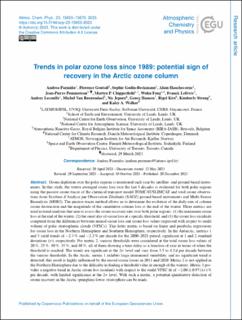| dc.contributor.author | Pazmiño, Andrea | |
| dc.contributor.author | Goutail, Florence | |
| dc.contributor.author | Godin-Beekmann, Sophie | |
| dc.contributor.author | Hauchecorne, Alain | |
| dc.contributor.author | Pommereau, Jean-Pierre | |
| dc.contributor.author | Chipperfield, Martyn P. | |
| dc.contributor.author | Feng, Wuhu | |
| dc.contributor.author | Lefèvre, Franck | |
| dc.contributor.author | Lecouffe, Audrey | |
| dc.contributor.author | Van Roozendael, Michel | |
| dc.contributor.author | Jepsen, Nis | |
| dc.contributor.author | Hansen, Georg H. | |
| dc.contributor.author | Kivi, Rigel | |
| dc.contributor.author | Strong, Kimberly | |
| dc.contributor.author | Walker, Kaley A. | |
| dc.date.accessioned | 2024-02-16T09:21:36Z | |
| dc.date.available | 2024-02-16T09:21:36Z | |
| dc.date.created | 2024-02-01T14:46:16Z | |
| dc.date.issued | 2023 | |
| dc.identifier.citation | Atmospheric Chemistry and Physics (ACP). 2023, 23 (24), 15655-15670. | en_US |
| dc.identifier.issn | 1680-7316 | |
| dc.identifier.uri | https://hdl.handle.net/11250/3118095 | |
| dc.description.abstract | Ozone depletion over the polar regions is monitored each year by satellite- and ground-based instruments. In this study, the vortex-averaged ozone loss over the last 3 decades is evaluated for both polar regions using the passive ozone tracer of the chemical transport model TOMCAT/SLIMCAT and total ozone observations from Système d'Analyse par Observation Zénithale (SAOZ) ground-based instruments and Multi-Sensor Reanalysis (MSR2). The passive-tracer method allows us to determine the evolution of the daily rate of column ozone destruction and the magnitude of the cumulative column loss at the end of the winter. Three metrics are used in trend analyses that aim to assess the ozone recovery rate over both polar regions: (1) the maximum ozone loss at the end of the winter, (2) the onset day of ozone loss at a specific threshold, and (3) the ozone loss residuals computed from the differences between annual ozone loss and ozone loss values regressed with respect to sunlit volume of polar stratospheric clouds (VPSCs). This latter metric is based on linear and parabolic regressions for ozone loss in the Northern Hemisphere and Southern Hemisphere, respectively. In the Antarctic, metrics 1 and 3 yield trends of −2.3 % and −2.2 % per decade for the 2000–2021 period, significant at 1 and 2 standard deviations (σ), respectively. For metric 2, various thresholds were considered at the total ozone loss values of 20 %, 25 %, 30 %, 35 %, and 40 %, all of them showing a time delay as a function of year in terms of when the threshold is reached. The trends are significant at the 2σ level and vary from 3.5 to 4.2 d per decade between the various thresholds. In the Arctic, metric 1 exhibits large interannual variability, and no significant trend is detected; this result is highly influenced by the record ozone losses in 2011 and 2020. Metric 2 is not applied in the Northern Hemisphere due to the difficulty in finding a threshold value in enough of the winters. Metric 3 provides a negative trend in Arctic ozone loss residuals with respect to the sunlit VPSC fit of −2.00 ± 0.97 (1σ) % per decade, with limited significance at the 2σ level. With such a metric, a potential quantitative detection of ozone recovery in the Arctic springtime lower stratosphere can be made. | en_US |
| dc.language.iso | eng | en_US |
| dc.rights | Navngivelse 4.0 Internasjonal | * |
| dc.rights.uri | http://creativecommons.org/licenses/by/4.0/deed.no | * |
| dc.title | Trends in polar ozone loss since 1989: potential sign of recovery in the Arctic ozone column | en_US |
| dc.title.alternative | Trends in polar ozone loss since 1989: potential sign of recovery in the Arctic ozone column | en_US |
| dc.type | Peer reviewed | en_US |
| dc.type | Journal article | en_US |
| dc.description.version | publishedVersion | en_US |
| dc.rights.holder | © Author(s) 2023. | en_US |
| dc.source.pagenumber | 15655-15670 | en_US |
| dc.source.volume | 23 | en_US |
| dc.source.journal | Atmospheric Chemistry and Physics (ACP) | en_US |
| dc.source.issue | 24 | en_US |
| dc.identifier.doi | 10.5194/acp-23-15655-2023 | |
| dc.identifier.cristin | 2242066 | |
| cristin.ispublished | true | |
| cristin.fulltext | original | |
| cristin.qualitycode | 2 | |

